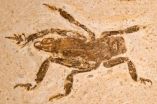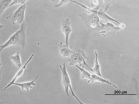Lund adopts chromosome 19
2011-02-04
(Press-News.org) The genes that make up the human genome were mapped by HUGO, the Human Genome Organisation, and published in 2001. Now the project is expanding into the HUPO, the Human Proteome Organisation. Within the framework of this organisation, many hundreds of researchers around the world will work together to identify the proteins that the different genes give rise to in the human body.
"The 'proteome', the set of all human proteins, is significantly more complicated than the genome. There are over 20 000 proteins coded by the genome in the human body and each protein can have a wide variety of forms, depending on where it is processed and localised and its function", says György Marko-Varga, clinical protein science leader at the Department of Measurement Technology and Industrial Electrical Engineering.
Last autumn, the protein researchers within HUPO decided to divide themselves into international networks and take on one chromosome each. The journal Nature has dubbed the initiative "Adopt-a-chromosome", and each network was able to 'claim' a chromosome in which they were particularly interested. Chromosome 19 was the obvious choice for the Lund researchers.
"Together with Professor Thomas Laurell, I have conducted research on the possibility of detecting the presence of prostate cancer using developments in microchip technology. We know that a number of proteins associated with prostate cancer are controlled by chromosome 19. Logically, it was an easy decision for us at Lund University to take on chromosome 19", says György Marko-Varga.
He is now the coordinator of a large network that had its first meeting at the Pufendorf Institute in Lund on 26 January. Researchers attended from Sweden, Norway, India, Germany, China and Spain.
Sequencing all the proteins linked to chromosome 19 is just the first step in the process. The next stage will be to develop methods to extract these specific proteins from, for example, a blood sample from a cancer patient. In the third stage, these methods will be used to see if any of the proteins from chromosome 19 are linked and correlated to prostate, brain or lung cancer, diabetes or cardiovascular disease. This will involve studying samples from biobanks (collections of tissue and blood samples) related to these diseases.
"Modern development of new drugs is almost entirely directed towards the target proteins that play a key role in a given disease. If you see that patients with a certain disease have abnormally high or low levels of a certain protein in their bodies then you can move on to see how this target protein is associated with the development of the disease. It may be possible to stop the disease by regulating the effect of the protein in question", says György Marko-Varga. "A good example is EGFR regulation in lung cancer, where I have been involved in probably the largest diagnostic study ever conducted, with thousands of patients, evaluating a personalised medicine drug in Asia."
The results of the work carried out in the network will be loaded into a publicly available database that can be used by both industrial and academic researchers worldwide.
INFORMATION: END
ELSE PRESS RELEASES FROM THIS DATE:
2011-02-04
Up to seven per cent biodiesel blended in regular diesel will presumably not cause greater health risks for the population than the use of pure fossil diesel. This is the main conclusion in a memorandum from the Norwegian Institute of Public Health and the Climate and Pollution Control Agency (formerly SFT) to the Ministry of Health and Care Services and the Ministry of the Environment in Norway.
"A higher content of biodiesel (up to 20 per cent) requires more research to assess health effects. This must include different types of biofuels and blending ratios, as well ...
2011-02-04
University of Manchester scientists have shown that a protein involved in blood clotting can be used to diagnose and subsequently monitor the treatment of a group of childhood genetic diseases.
In the study, published in the Journal of Inherited Metabolic Disease, the researchers were able to show that the clotting agent, heparan cofactor II/Thrombin (HCII/T) complex, could be used as a 'biomarker', or biological tell, in individuals with mucopolysaccharide (MPS) diseases.
MPS diseases are severe metabolic conditions caused by a genetic defect that affects the body's ...
2011-02-04
University of Granada scientists have been the first to analyze the relation between drug abuse and recognition of basic emotions (happiness, surprise, wrath, fear, sadness and disgust) by drug-abusers. Thus, the study revealed that drug-abusers have difficulty to identify negative emotions by their facial expression: wrath, disgust, fear and sadness.
Further, regular abuse of alcohol, cannabis and cocaine usually affects abusers' fluency and decision-making. Consuming cannabis and cocaine negatively affects work memory and reasoning. Similarly, cocaine abuse is associated ...
2011-02-04
Pacific Northwest farmers could someday be filling up their machinery's tanks with fuels produced from their own fields, according to ongoing research by U.S. Department of Agriculture (USDA) scientists.
Since 2003, Agricultural Research Service (ARS) microbiologist Hal Collins and agronomist Rick Boydston have been studying safflower, camelina, soybeans, mustard, canola, wheat, corn and switchgrass to assess their potential for bioenergy production. ARS is USDA's chief intramural scientific research agency, and this research supports the USDA priority of developing ...
2011-02-04
Moving to a new country is difficult—learning the cultural rules and meanings of your new home is especially challenging. A new study published in Psychological Science, a journal of the Association for Psychological Science, finds that this process is easier for children, but quickly becomes more difficult after about the age of 15.
Psychological scientists have found that many aspects of learning and development have a critical window—if a developmental event doesn't happen by a particular age, it never will. For example, learning perfect pitch or learning to see with ...
2011-02-04
Camden, N.J., February 3, 2011– Studies show drinking V8® 100% vegetable juice may be a simple way for people to increase their vegetable intake and may help them manage their weight – two areas of concern outlined in the newly released 2010 U.S. Dietary Guidelines for Americans.1
A study conducted by researchers at the University of California-Davis found that adults who drank one, 8-ounce glass of vegetable juice each day, as part of a calorie-appropriate Dietary Approaches to Stop Hypertension (DASH) diet, got nearly twice as many vegetable servings a day than those ...
2011-02-04
CHAMPAIGN, Ill. — Researchers have discovered the 100 million-year-old ancestor of a group of large, carnivorous, cricket-like insects that still live today in southern Asia, northern Indochina and Africa. The new find, in a limestone fossil bed in northeastern Brazil, corrects the mistaken classification of another fossil of this type and reveals that the genus has undergone very little evolutionary change since the Early Cretaceous Period, a time of dinosaurs just before the breakup of the supercontinent Gondwana.
The findings are described in a paper in the open access ...
2011-02-04
MBL, WOODS HOLE, MA—The ubiquitous freshwater "water flea," Daphnia pulex, may be too small to see, but it has amply proven its value as an "sentinel species" for the presence of toxins and pollutants in the environment.
Daphnia's response to exposure to toxic metals and other chemical pollutants is well studied, and this information is routinely used by groups such as the US Environmental Protection Agency (EPA) to define regulatory limits, and to monitor industrial and municipal discharges.
This week, Daphnia pulex is receiving an enormous pat on the back from the ...
2011-02-04
Earth observation scientists at the University of Leicester have recorded stunning images of tropical cyclone Yasi by orbiting satellites.
Japanese Meteorological Agency and European Space Agency satellite instruments have been observing the intense storm over Australia from their vantage points in space.
University of Leicester scientists have used two instruments, MTSAT-2 and MERIS, which have enabled the scientists to follow the progress of the storm as it headed towards and then struck the Australian coast. They have provided unique views from space of a storm ...
2011-02-04
Cancer researchers have discovered that a type of regulatory RNA may be effective in fighting ovarian cancer. Ovarian cancer isn't typically discovered until it's in the advanced stages, where it is already spreading to other organs and is very difficult to fight with chemotherapy. This new discovery may allow physicians to turn back the clock of the tumor's life cycle to a phase where traditional chemotherapy can better do its job.
Scientists at the Ovarian Cancer Institute Laboratory at the Georgia Institute of Technology have found in initial tests that a regulatory ...
LAST 30 PRESS RELEASES:
[Press-News.org] Lund adopts chromosome 19



